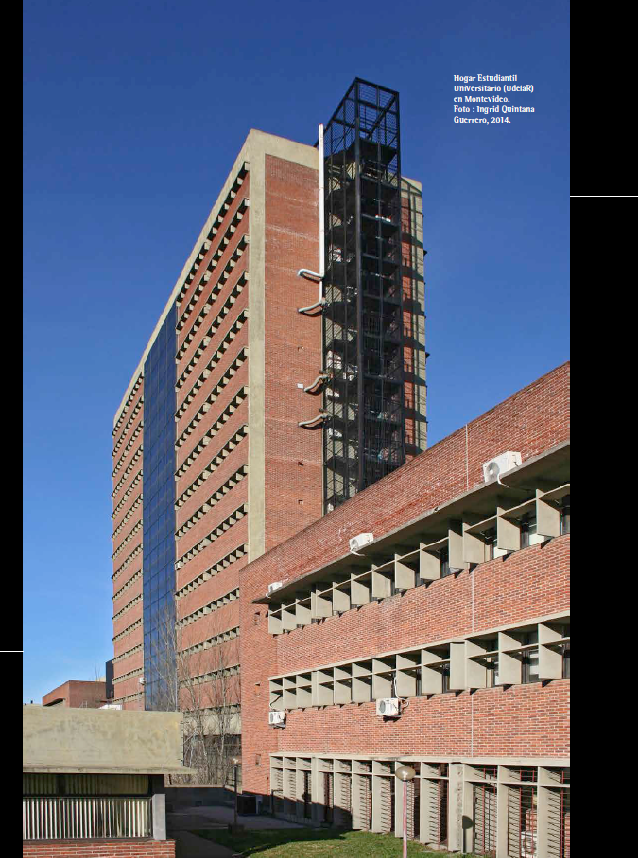Resumen
Este artículo propone una mirada transversal a parte de la producción arquitectónica del uruguayo Justino Serralta en su país, posterior a su práctica profesional en el taller parisino de Le Corbusier. Dicha producción tuvo como colofón el desarrollo de un sistema cósmico, filosófico y de pretendido carácter universal: El Unitor. En el texto se insinúan vínculos entre dicha producción -material e intelectual-, sustentados en un recorrido somero por la contribución de Serralta a uno de los talleres de arquitectura más afamados de su tiempo; recorrido sustentado en su mayoría por información inédita recopilada en la Fondation Le Corbusier - FLC. El artículo presenta posibles vertientes de profundización de esos nexos, bien sea desde los aspectos técnicos y compositivos (materia inaugurada por Nudelman), o bien desde las ideologías e imaginarios que subyacen en su inquietud plástica, su actividad docente y sus escritos. Esta última vertiente, truncada por la muerte del arquitecto, carece de un estudio acucioso a la luz del universo lecorbusieriano, que este trabajo se propone convocar.
Noguez, L. (2010). Un uruguayo testigo de la intensidad lecorbusiana: entrevista a Justino Serralta. En Fundación Pablo Atchugarry, Le Corbusier el artista. Grandes obras de la colección Heidi Weber. Catálogo de la exposi¬ción (pp. 165-171). Punta del Este: Fundación Pablo Atchugarry. Recuperado de https:// issuu.com/fundacionpabloatchugarry/docs/ le_corbusier_el_artista
Nudelman Blejwas, J. (2011). Modulor 2 - La pesada carga de la perfección. Le Corbusier en Serralta y Clémot, y en Dieste. Arquitex¬tos, 12(138.03). Recuperado de http://www. vitruvius.com.br/revistas/read/arquitex-tos/12.138/4116
Nudelman Blejwas, J. (2013). El Hogar Estudiantil Universitario de Carlos Clémot y Justino Serralta: reconstruir la Unité. Curitiba: Do¬comomo Brasil - Conexiones Brutalistas.
Nudelman Blejwas, J. (2013). Tres visitantes en París. Los colaboradores uruguayos de Le Corbusier (Tesis de doctorado). Escuela Su¬perior Técnica de Arquitectura de Madrid, Madrid.
Quintana Guerrero, I. (2016). Filhos da Rue de Sèvres: os colaboradores latino-americanos de Le Corbusier em Paris (Tese de doutora¬do). Universidade de São Paulo, São Paulo. Recuperado de http://www.teses.usp.br/ teses/disponiveis/16/16133/tde-16022017- 113246/es.php
Sequeira, M. (2008). A cobertura da Unité d’Habitation de Marselha e a pregunta de Le Corbusier pelo lugar público (Tese de doutorado). Universitat Politécnica de Cata¬lunya, Barcelona.
Ser ralta, J. (1981). L’Unitor. Rennes: École d’architecture de Rennes.
Serralta, J. (1995). El Unitor. Montevideo: Edi¬ciones Trilce. Fundación de Cultura Uni¬versitaria.
La revista Apuntes se encuentra registrada bajo la licencia Creative Commons Reconocimiento 4.0 Internacional. Por lo tanto, esta obra se puede reproducir, distribuir y comunicar públicamente en formato digital, siempre que se reconozca el nombre de los autores y a la Pontificia Universidad Javeriana. Se permite citar, adaptar, transformar, autoarchivar, republicar y crear a partir del material, para cualquier finalidad (incluso comercial), siempre que se reconozca adecuadamente la autoría, se proporcione un enlace a la obra original y se indique si se han realizado cambios. La Pontificia Universidad Javeriana no retiene los derechos sobre las obras publicadas y los contenidos son responsabilidad exclusiva de los autores, quienes conservan sus derechos morales, intelectuales, de privacidad y publicidad.
El aval sobre la intervención de la obra (revisión, corrección de estilo, traducción, diagramación) y su posterior divulgación se otorga mediante una licencia de uso y no a través de una cesión de derechos, lo que representa que la revista y la Pontificia Universidad Javeriana se eximen de cualquier responsabilidad que se pueda derivar de una mala práctica ética por parte de los autores. En consecuencia de la protección brindada por la licencia de uso, la revista no se encuentra en la obligación de publicar retractaciones o modificar la información ya publicada, a no ser que la errata surja del proceso de gestión editorial. La publicación de contenidos en esta revista no representa regalías para los contribuyentes.



